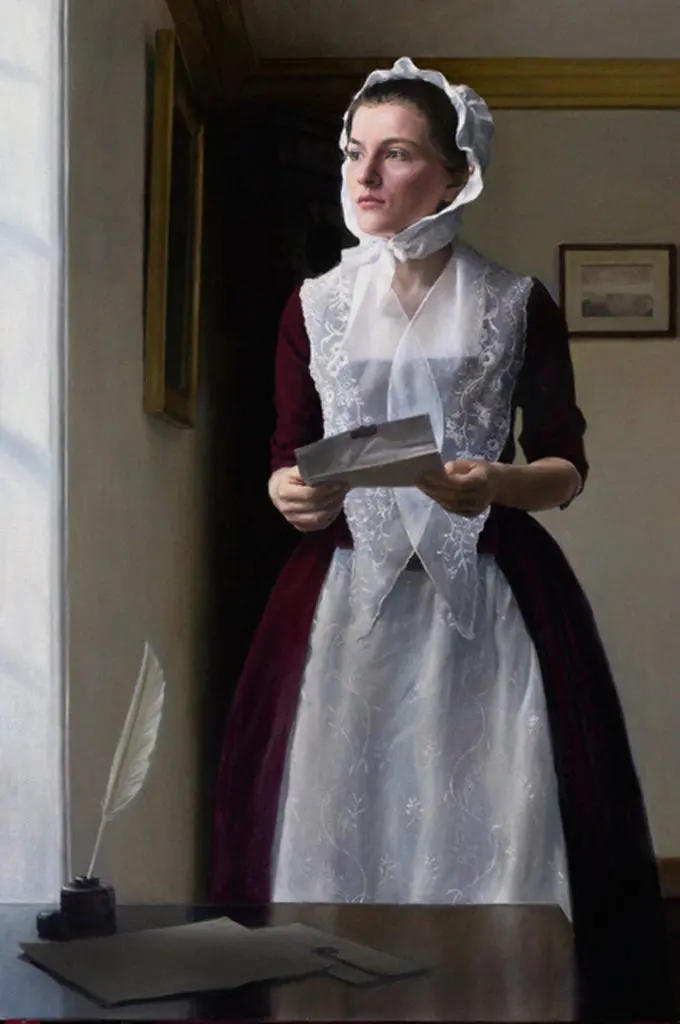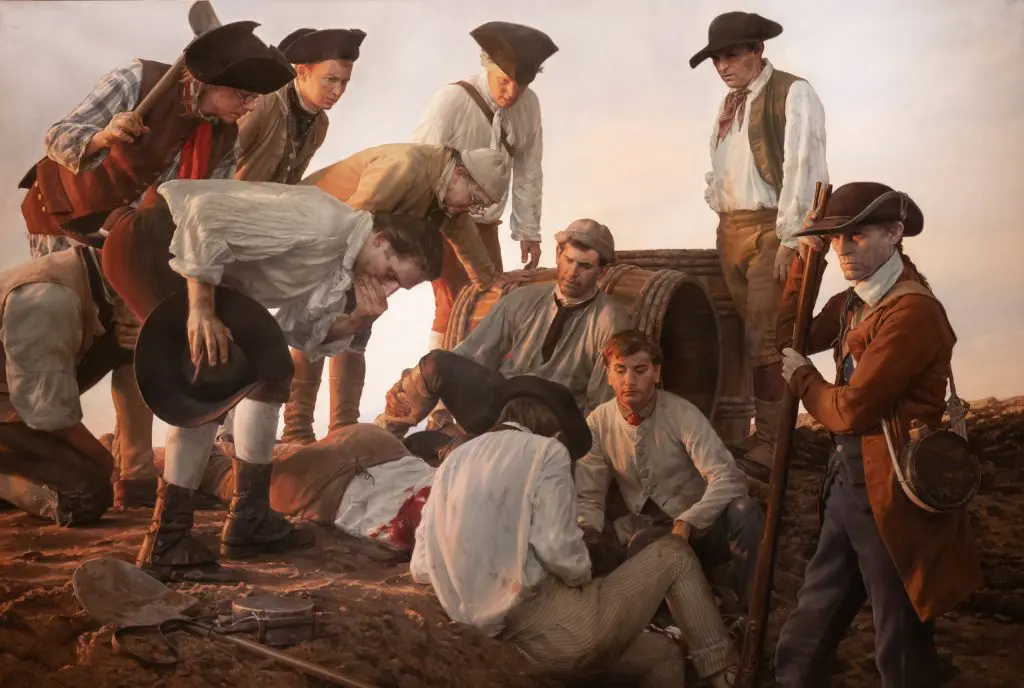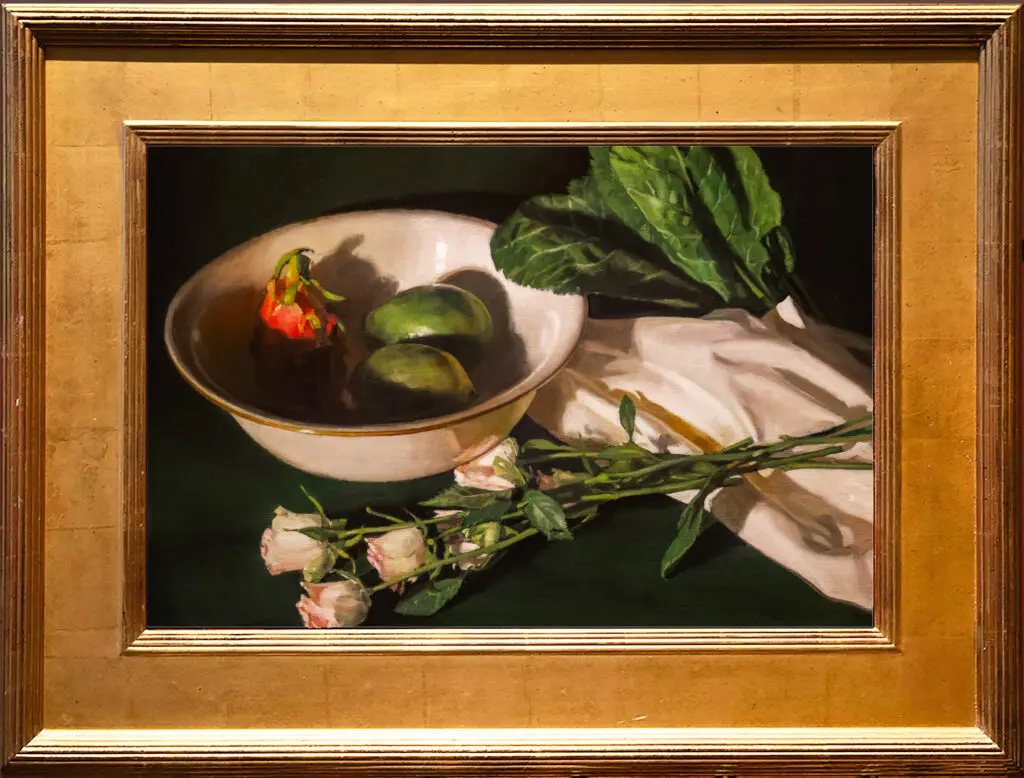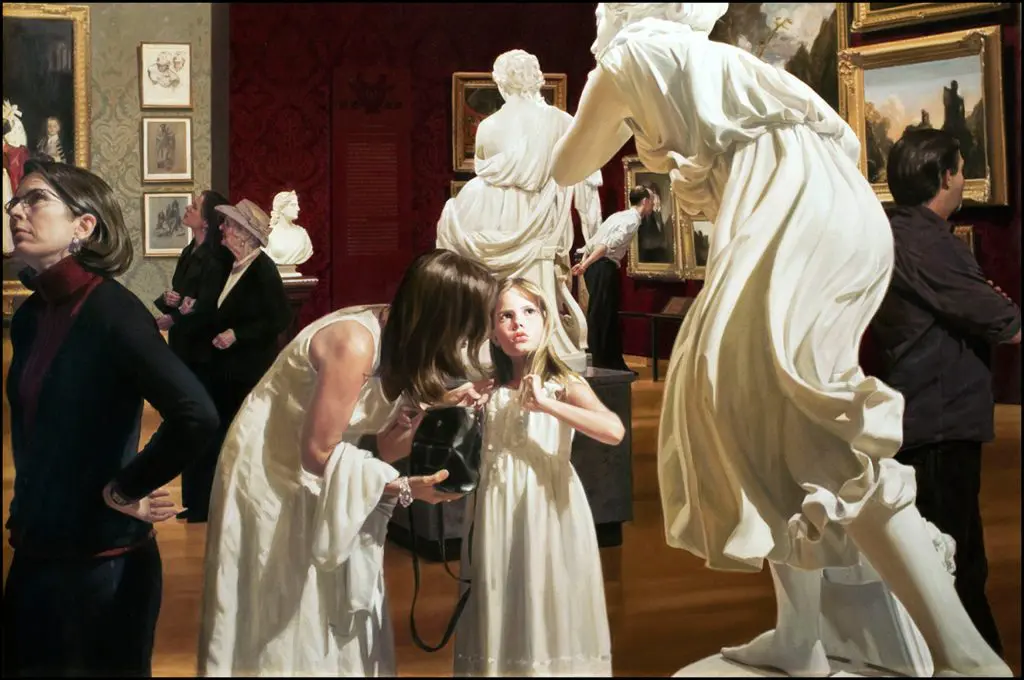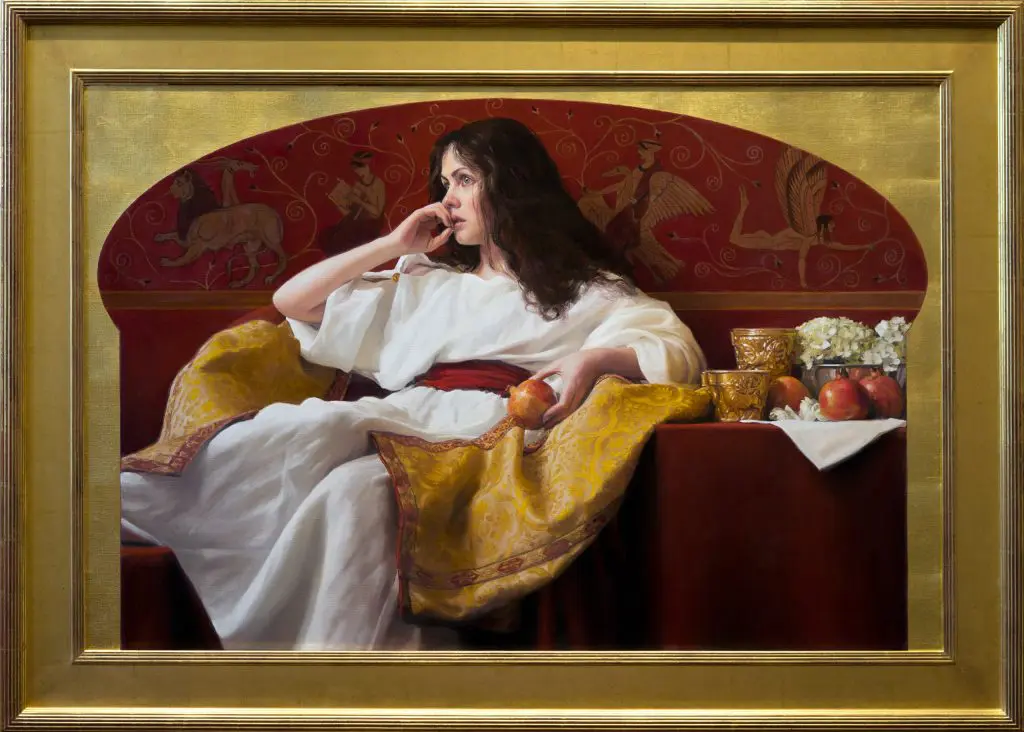Our Work
Written by: Lucia R. Prosperi

Prosperi Studio was created in 1974 when Warren and I met in Cambridge, Massachusetts. I had just graduated from Hampshire College with a degree in the Humanities & Arts. Warren had just finished his immersion in teaching himself the craft of classical painting, by setting up his easel in front of such painters as Rubens, Rembrandt, Millet and Chardin at the Museum of Fine Arts (MFA) in Boston. Visiting the Museum daily he copied the old masters’ paintings to deconstruct and to learn their technique, and to immerse himself in their aesthetics. For specific questions he often referred to restoration manuals as well.
On a parallel path, my fascination with photography became a full-time study of its history, technique, and relationship with painting. My understanding was greatly deepened by reading the work of the remarkable philosopher Susanne Langer. Her theory of art was developed from her examination of the studio perspective and eventually evolved as the basis for her theory of mind. I draw on her insights daily in our work.
With such complementary interests we decided we wanted to work together to build a life centered around optical naturalism, a four-hundred-year-old branch of classical painting, emphasizing light over object in painting. Our respect and resonance for its power in prior times, irrevocably caught our imaginations for exploring our own times.
Studio Perspective
From our studio perspective, paintings fall into two streams of thought: Naturalism, which focuses on the world around us, and Symbolism, which focuses on the world within us. With both these streams, we look to build images concerned with existential and ethical questions.
As Warren elaborates in his Symbolist Journal: “All visual art is either Naturalism or Symbolist. It’s rooted either in the perceived object or rooted in the perceiving subject. Since these are intrinsically fused, the objective and the subjective are always inseparable.”
Our portfolio is built from these two distinct streams of work. Since our perspective is from the studio, and not of the historian or critic, our thinking is always rooted in two questions: what is the expressive idea; and how to construct and execute a painting which embodies it?
As Degas wrote: “Art is not what you see, but what you want others to see.” As cryptic as his statement is, we adopted it as the spirit of Prosperi Studio, now for almost fifty years. How exactly is this done? We offer our paintings as our best effort to explore this question.
Pausing to reflect while writing this, I realize what binds it all together is that Warren is a painter immersed in the classical tradition and its relevance to contemporary life, and I am a photographer immersed in the studio perspective of painting, as well as its relationship with photography, and the structure of a moment. Everything we offer on our site is from this perspective.
“Painting, like photography, excels in its ability to capture a particular moment of light and gesture.
But the painter’s greater range of technique can more easily help our minds travel from the particular to the universal.
The complexity of Prosperi’s technique paradoxically uses the way our brains perceive images to move us beyond perception, to give an experience of more direct contact with the world around us.” – Alice Flaherty, MD, PhD
Portraits
Portraits have been the foundation of our work from the beginning. We always engage with two questions when making a portrait:
What is the character of our subject?
How do we understand and present them in a pivotal, i.e. telling moment?
By asking these questions when we begin a portrait, our answers are as individual as our subjects and slowly emerge from our many conversations with them.
It usually takes a while for people to understand how two people can make a portrait when only one goes to the easel. What makes this possible is the bridge between artist-and-subject that Warren and I build together. We explore this long before I pick up my camera to provide Warren with the necessary source material. The source material always emerges from our shared experience of our subject. He then makes a painting that functions as a study to allow the subject to visually see what the finished painting will almost look like. It is at this crossroads that our subject can visually see and get a strong sense of what is working, and just as importantly, what is not. This process assures us that we are all moving in the same direction before Warren begins the actual portrait itself.
Our portraits have been commissioned by numerous institutions, some of the highlights are Bowdoin College, Brown University, College of the Holy Cross, Emerson College, Georgetown University, Hampshire College, and Johns Hopkins University. We are privileged to have a long-standing partnership with Massachusetts General Hospital (MGH) and with Brigham’s and Woman’s Hospital, where, between them, we have well over sixty-five portraits, hanging on their walls with more to come. We also have numerous privately commissioned portraits throughout the United States and Europe.
However, our interest in human character is not limited to our commission work. We often ask people who are compelling in their individual way, to allow us to make their portrait. Eventually we hope that we can gather these paintings together as a retrospective to honor these encounters.
Historical Paintings
Our historical paintings which include portraits, paintings referencing old-black-and-white photographs, and murals, are rooted in the same two questions raised earlier:
What is the character of the subject?
How do we understand and present them in a pivotal, i.e. telling moment?
Three decades ago, we realized our methodology for our contemporary portrait work provided a roadmap for our historical work. This insight allowed us to time-travel in a sense, whether we were creating a mural of the first public demonstration of ether in 1846 in the MGH Ether Dome, making a portrait of Abigail Adams in her home reading a letter from her husband John Adams, or using our years of experience with portraiture to learn more about Harriett Tubman, from examining old black-and-white photographs of her. All our historical projects are about people who travelled before us, but still reach into our present, influencing and shaping it, sometimes in ways many of us are still trying to understand.
Historical Portraits
During Covid my cousin purchased a thatched roof rectory in Dorsett, England, which she converted into a B&B. It turned out its rector in the 19th century, William Barnes, drew luminaries such as Thomas Hardy, T. E. Lawrence, and Alfred Tennyson, to name a few of the most well-known visitors.
Since Warren and I had always been fascinated by old black-and-white photographs as sources to better understand historical figures, the Covid lock-down and my cousin’s project provided a perfect opportunity to explore what the synthesis of Warren’s years of painting portraits might yield using black-and-white photographs as source material.
What we discovered is that a portrait from an old photograph reveals an ineffable and often elusive aspect of a person’s presence, that can be felt, but not always articulated verbally, but often best embodied through images. This discovery was illuminating and exciting. For us it opened a way of not only gaining insight, but perhaps also contributing to the conversation with those as interested as we are in the character of those that came before us. Each painting has been an act of discovery and a joyous endeavor.
For paintings of historical figures who predate photographs, we rely on descriptions and renderings for likeness, and research the context in which they were living as well. As with our contemporary portraits, picking and staging a pivotal moment, is just as critical to historical portraits.
An example of such a painting is our commissioned portrait of Abigail Adams. To deepen our understanding of who she was and the life she led, we visited the Adams’ first home in Quincy, Massachusetts. After researching and thinking about her significant role and relationship with John Adams in the formative years of the American Revolution, we chose to portray her reading one of John’s letters at their home. Then we found a model who resembled her at the time when John was in Europe and their only connection was their letters. We, then, commissioned historical seamstresses to make an outfit like the one she would have worn. Finally, we staged and photographed the moment, providing Warren excellent source material for his painting.
In the process of constructing the image, we had to understand each element that contributed to making it seem as if Abigail was at home reading John’s letter. In doing that we were able to respond to our own two questions each history project raises: What is the character of the subject? How to understand and present in a pivotal moment?
Historical Murals
Our first commissioned historical murals were for the Joslin Clinic in Boston in the early 90’s. These include seven murals of important doctors and moments which constitute its foundation and now hang permanently in its lower lobby. Following this, MGH commissioned us to paint Ether Day, 1846, depicting the first public demonstration of the effectiveness of ether in surgery. Hanging permanently in the historic landmark of the Ether Dome in MGH’s Bulfinch Building, people from all over the world regularly make their pilgrimage to where ether and surgery were publicly combined, changing medicine forever. Subsequently Rhode Island Hospital (RIH) commissioned two large murals depicting Nursing Care in 1867 and 2003 for its main lobby.
Most recently, we completed two privately funded murals of The First Casualty of Bunker Hill, and Sam Whittemore Stands Down the British Regulars depicting the everyday citizen creating two prominent moments of US history. We hope they will eventually hang in Boston near the Freedom Trail and become part of the story telling of Boston’s contributing role in the beginnings of the American Revolution.
Landscapes, Figure & Still Life
Shapes, colors, and tonal relationships are the elements that construct all paintings. Yet the shift away from the rigors of likeness that portraiture demands, frees our attention to emphasize gesture, design and lighting.
Painting landscapes, both commissioned and non-commissioned, have taken us to many destinations, solely for the purpose of making paintings. When we were in the Tuileries Garden in Paris, preparing for our London exhibition (1999), we had a moment when we just looked at each other and realized how incredible it was that this was our work. Places we have visited since then, such as Venice, Cornwall and Monument Valley, have continued to reinforce our Tuileries realization.
Our figure paintings, like our landscape paintings, free our attention from the likeness demand inherent and compelling in portraiture. Whether it’s Warren falling in love with the intricacies of an antique Chinese coat, light falling on a figure outside, and/or an epiphanous moment of a visitor in a museum, the design, light, and expressive gesture opportunities are periodically a welcome counterpoint to the rigors of portraiture.
Our landscape and figure paintings are hanging across the United States and Europe. We even had Lord Sainsbury, after seeing our landscape and figure work from our London exhibition, commission a painting of his estate. Sadly, he passed during the planning stage, and we lost this opportunity to work with him.
A little more than a decade later, Vose Gallery in Boston mounted a solo show, exhibiting our landscape and figure paintings of New England. Even in such a familiar setting, it never ceases to amaze us how much there is to see wherever we find ourselves, as long as we keep looking attentively.
In Susan Boulanger’s review of the Vose Exhibit for Art New England, she wrote:
“…in exploring the fall of light on objects and figures in naturally rendered environments, Prosperi exalts values of clarity, simplicity and directness familiar in Jan Vermeer and other masters of form.”
Still Life
While commission work has its own rhythm, when there are gaps, we have discovered the joy of time for studio projects. Recently, we had just finished months of intensive portrait work when a gallery director asked if we had any still life paintings for a possible inclusion in an exhibit. We did not and a seed was planted.
Warren had not painted still life paintings in years, so the lure of color and shapes, arranged for certain effects, with no demand for specific likeness as in portraiture caught Warren’s imagination. I too fell under this spell. And as often happens with us, the creation of one painting invites another…until there were six.
Epiphany
Warren’s early time spent copying at the Museum of Fine Arts (MFA) in Boston was not only an opportunity to learn about classical painting, but also a chance to experience museum visitors passing through the galleries in a steady stream, as he was stationary at his easel studying one painting at a time. He became fascinated by the relationship between visitors and their examination and experience of the art surrounding them. He has told me stories of how kids, seemingly half-asleep on their tours through the museum, became alert and vibrant when they stumbled upon him at his easel trying to mirror the painting they too saw on the wall. Mesmerized and magnetized, they lit up with questions and observations they were eager to share with him.
His experience and reflection gave rise to the Epiphany Series which came to a lovely crescendo in our painting Epiphany 3. As a contemporary painting of the 19th century gallery it was hanging in, it was the ultimate mirroring in real-time of the visitor’s gallery experience. It is a painting rooted in his memories, its creation almost an homage to the museum’s landscape and its ever-yielding offering to viewer and artist alike.
It was a great honor for both of us when it was donated by Victoria and David Croll to the permanent collection of the MFA and hung for eight years in the Penny and Jeff Vinik Gallery.
Speaking of Warren and our project at its unveiling in 2014, David said:
“He’s probably one of the best contemporary figurative painters I’ve seen…you know it’s a current artist, with a sensibility that’s modern, but it’s also an academic painting, classically representational…He draws allusions to Caravaggio, Velazquez, Sargent…He’s trying to capture a moment with a figure reacting to surroundings. An ’aha’ moment. Even with a portrait.”
Symbolist Stream
Our Symbolist stream has generated: First Things, eight paintings examining origin stories; twelve Psyche paintings illustrating her journey; and three paintings depicting the Oresteia story. Warren writes about each of these projects in depth under Symbolist Gallery on this site.
Conclusion
This backstory tale has clearly shaped us to the present. Recognizing this, I want to conclude with Warren’s poem that he wrote somewhere in the middle years of our journey together, trying to understand others and the world around us. I still can’t read it without feeling the depths of its reach towards our never wavering, but never assured intention.
Tender Souls All
All these faces are mine.
All these moments belong to me.
Oh my heart of my transformations,
Bind me end to end.
Oh lustrous apparition of time,
Shred your lovely duplicity,
And show me tender souls all,
Our common breath.
Warren Prosperi
Many thanks to Zach Luse, Founder, and the team at Paragon Digital Marketing for creating this beautiful platform that is now a virtual extension of a visit to our studio. Special thanks to Grace Quinn, our Paragon project manager, for her guidance, responsiveness, patience, and excellent management of this project.

